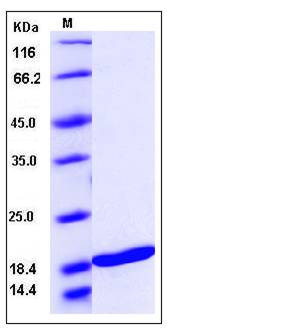Human TNFSF10 / TRAIL / APO-2L / CD253 Protein
APO2L, Apo-2L, CD253, TL2, TRAIL
- 100ug (NPP4327) Please inquiry
| Catalog Number | P10409-HNAE |
|---|---|
| Organism Species | Human |
| Host | E. coli |
| Synonyms | APO2L, Apo-2L, CD253, TL2, TRAIL |
| Molecular Weight | The recombinant human TNFSF10 consisting of 169 amino acids and has a calculated molecular mass of 19.6 kDa. It migrates as an approximately 19 kDa band in SDS-PAGE under reducing conditions. |
| predicted N | Met |
| SDS-PAGE |  |
| Purity | > 97 % as determined by SDS-PAGE |
| Protein Construction | A DNA sequence encoding the human TNFSF10 (NP_003801.1) (Val 114-Gly 281) with an initial Met was expressed and purified. |
| Bio-activity | 1. Measured in a cytotoxicity assay using L929 mouse fibrosarcoma cells in the presence of the metabolic inhibitor actinomycin D . The ED50 for this effect is typically 2-10 ng/ml . 2. Measured in a cytotoxicity assay using NCI-H460 cells in the presence of the metabolic inhibitor actinomycin D . The ED50 for this effect is typically 0.2-0.8 ng/ml . |
| Research Area | Cardiovascular |Angiogenesis |Cytokine & Receptor |Tumor Necrosis Factor (TNF) & Receptor |Tumor Necrosis Factor (TNF) |
| Formulation | Lyophilized from sterile 40mM Tris, 0.3 M NaCl, pH 7.0 1. Normally 5 % - 8 % trehalose and mannitol are added as protectants before lyophilization. Specific concentrations are included in the hardcopy of COA. |
| Background | Tumor necrosis factor ligand superfamily member 10 (TNFSF10), also known as TNF-related apoptosis-inducing ligand (TRAIL), Apo-2 ligand, and CD253, is a cytokine that belongs to the tumor necrosis factor (TNF) ligand family. TNFSF10 / Apo-2L / CD253 functions as a ligand that induces the process of cell death called apoptosis. TNFSF10 / TRAIL shows homology to other members of the tumor necrosis factor superfamily. As one member of the cluster of differentiation system, TNFSF10 / CD253 is commonly used as cell markers in immunophynotyping. Different kinds of cells in the immune system can be identified through the surface CD molecules which associating with the immune function of the cell. There are more than 320 CD unique clusters and subclusters have been identified. Some of the CD molecules serve as receptors or ligands important to the cell through initiating a signal cascade which then alter the behavior of the cell. Some CD proteins do not take part in cell signal process but have other functions such as cell adhesion TNFSF10 / Apo-2L / CD253 / TRAIL binds to several members of TNF receptor superfamily including TNFRSF10A / TRAILR1, TNFRSF10B / TRAILR2, TNFRSF10C / TRAILR3, TNFRSF10D / TRAILR4, and possibly also to TNFRSF11B/OPG. The activity of TNFSF10 / TRAIL may be modulated by binding to the decoy receptors TNFRSF10C / TRAILR3, TNFRSF10D/TRAILR4, and TNFRSF11B/OPG that cannot induce apoptosis. The binding of this protein to its receptors has been shown to trigger the activation of MAPK8 / JNK, caspase 8, and caspase 3. Alternatively spliced transcript variants encoding different isoforms have been found for this gene. |
| Reference |
